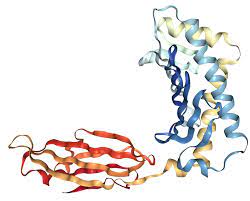FCRN/FCGRT Protein Sequence, Structure
The intestinal epithelium of newborn mice and rats expresses an Fc receptor (FcRn) that mediates the selective uptake of immunoglobulin G (IgG) into breast milk, helping newborn animals to acquire passive immunity.
Kandil et al. (1996) noted that IgG in milk is bound to FcRn at the apical surface of the intestinal epithelium and the resulting FcRn-IgG complexes are transcytosed through the epithelium. At the basolateral surface of intestinal epithelial cells, IgG is released from FcRn into the blood or tissue fluids. FcRn is structurally similar to the major histocompatibility complex class I molecule, which presents antigenic peptides to T cells.
Like the MHC class I molecule, FcRn is composed of a heavy chain (about 48 kD) and beta-2-microglobulin (109700; about 12 kD). Its heavy chain has approximately 35% amino acid sequence identity with that of a typical MHC class I molecule. are similar in that the signal peptide, the 3 extracellular domains, the transmembrane region and the cytoplasmic region are all encoded by separate exons.

Story et al. (1994) cloned a cDNA encoding the human gene and symbolized it FcRn. Kandil et al. (1996) isolated human genomic clones for the gene (symbolized as FCGRT by them) using 2 murine Fcgrt probes. The exon sequences of the genomic clones are identical to the cDNA sequence described by Story et al. (1994)..
The p51 large subunit of the IgG FcRn receptor (UniProt: Q61559; also known as FcRn, IgG Fc fragment receptor transporter alpha chain, neonatal Fc receptor) is encoded by the Fcgrt gene (also known as of Fcrn) (Gene ID: 14132) in murine species. FcRn is a single-pass type I membrane protein that binds to the Fc region of monomeric gamma immunoglobulins.
The FcRn complex consists of two subunits: p51 and p14 and contains an Ig-like (immunoglobulin-like) C1-like domain of 88 amino acids. FcRn mediates the selective uptake of IgG from milk and helps newborn animals to acquire passive immunity.
In rodents, FcRn functions efficiently during the neonatal period when it transports maternally derived IgG in ingested milk across the epithelial cell layer of the proximal small intestine. However, in humans, it carries maternal antibodies to the fetus through the placenta. In rodents, FcRn-IgG complexes are transcytosed across the intestinal epithelium and IgG is released from FcRn into blood or tissue fluids.
FcRn also protects IgG from degradation by providing a long half-life of this class of antibodies in serum. (Ref: Roopenian,, DC and Shreeram,, A (2007). Nat. Rev. Immunol
